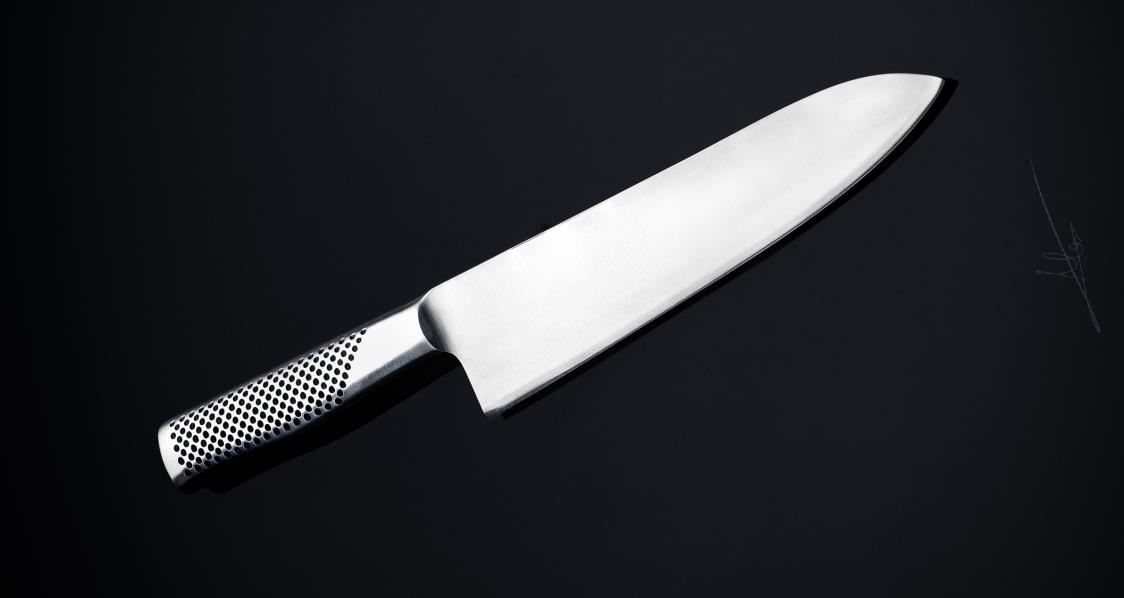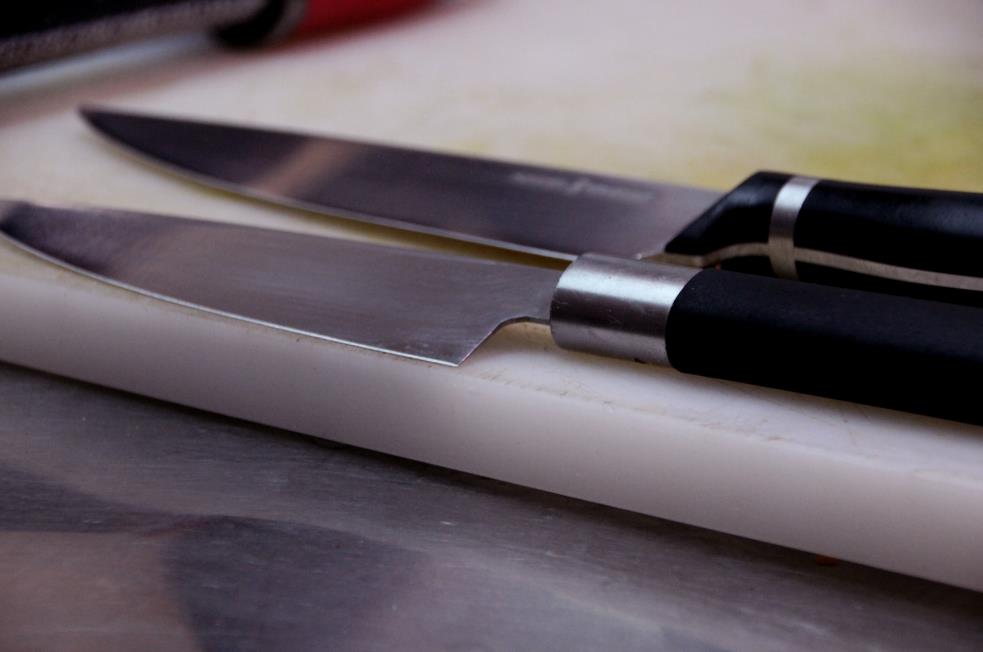Stainless steel kitchen knives are the favorites of many amateur and expert chefs. They are durable, their shiny silver blades look great, and they tend to be reasonably priced. A popular grade of stainless steel is the 400 series. Among these, the alloy 420 is used frequently to make both kitchen and outdoor knives. So how does this material behave, and is it worth paying for a 420 steel knife?
420 steel is a popular alloy that is used for both cutlery and kitchen knives. It primarily consists of iron and chromium but contains small amounts of carbon plus other metals too. Like other kinds of stainless steel, 420 steel receives praise for its good corrosion resistance and durability. It will not hold an edge for very long but overall is a very good knife for beginners.
Now we will show you the composition of 420 stainless steel, its applications, plus how it performs in kitchen knives. The upcoming sections should help curious readers to decide if this is a suitable knife material for them.
Table of contents
What is 420 steel?

The SAE numbering system organizes different groups of stainless and carbon steels. According to this system, the 400 group contains metals known as martensitic chromium alloys. Starting from 403 and going up to 440, you find that the alloys have increasing amounts of carbon and chromium. In every alloy, iron is by far the most dominant element.
Chemical composition
- Carbon (C): 0.15-0.38%
- Chromium (Cr): 12-14%
- Manganese (Mn): < 1%
- Silicon (Si): < 1%
- Phosphorus (P): < 0.04%
- Sulfur (S): < 0.03%
The carbon content of 420 steel is relatively low, even compared to other 400-series alloys, such as 440. This significantly impacts the metal’s hardness.
On the other hand, chromium is very important for protecting the metal from corrosion. This works by creating a layer of chromium oxide on the blade’s surface to stop rust from forming within the metal. As we will explain, this is hugely beneficial in a kitchen environment.
420 steel properties: how does it perform as a kitchen knife?
Since 420 steel is not very hard, you may find that you need to sharpen a 420 steel knife a lot. If you use it often, the edge will wear down quite fast, though compared to carbon steel, it is not difficult to sharpen again. The blade is not very stiff either ― you may find that it bends while cutting certain foods.
The advantage of a 420 steel knife lies in a couple of areas. Firstly, like other stainless steel grades, the corrosion resistance is superb. Though not the highest, a chromium content of over 12% helps to keep rust at bay. No steel is completely immune to rust, but you will spot early signs of rust on 420 steel very easily.
As a consequence, you don’t have to worry about always keeping your knife dry. This is great for busy chefs who do not have time to constantly wash and dry every knife they use. The anti-rust properties of 420 steel explain why it is such a popular material for hunting and diving knives.
The slightly low carbon content limits the hardness of 420 steel. Yet this is also a blessing. A potential weakness of high carbon knives is brittleness. Thankfully, 420 steel can absorb lots of energy without cracking. Beginners can drop a 420 steel knife occasionally without any worries. The toughness of this alloy is useful for hunting knives, where high-energy strikes are common.
Pros and cons of 420 steel: a brief overview
Pros
- Appearance: The shiny silvery finish of a stainless steel blade is a thing of beauty. 420 stainless steel is very eye-catching and looks great in both cutlery and knives
- Toughness: 420 steel is not brittle. Striking a cutting board hard with one of these knives will not cause damage. 420 steel knives can survive many falls too, which is handy for beginners or less confident chefs.
- Easy to sharpen: Most knives will wear down eventually. 420 steel is not very hard, so a quick sharpening session will return the blade to its original condition.
- Corrosion resistance: The chromium within the alloy prevents iron oxide (i.e. rust) from forming. This helps to maintain the blade’s beautiful shiny finish for longer
- Price: Whether you’re looking for a kitchen knife or a pocket knife, you will rarely see a 420 steel knife that costs more than $100. This is something that most people can afford
- Versatility: This stainless steel is useful for manufacturing knives plus cutlery and even surgical tools. The physical properties of this metal are desirable in many industries.
Cons
- Edge retention: The somewhat low amount of carbon in a 420 steel knife means that the edge will not hold for as long as a carbon steel knife. Sharpness is critical for preparing ingredients efficiently and safely. If you use your knife frequently, you may need to sharpen it often to keep it in top condition.
- Stiffness: The hardness of a knife blade will prevent it from flexing while cutting. 420 stainless steel is quite soft, so unless it undergoes heat treatment, a 420 steel knife may bend when cutting tough ingredients. This can be very annoying for skilled chefs.
420 vs 440 steel

440 steel is another very popular grade from the 400 stainless steel series. The main difference between the two grades is that 440 stainless steel has more chromium (16-18%) and more carbon than 420 steel. 440 steel also contains some molybdenum (0.75%). Otherwise, 420 and 440 steel have equal amounts of other elements.
440 stainless steel comes in three varieties; 440A, 440B, and 440C. What distinguishes these three metals is their carbon content, which is as follows:
- 440A: 0.6-0.75%
- 440B: 0.75-0.95%
- 440C: 0.95-1.20%
Despite being stainless steel, the 440 grade can have anything from a medium to a high carbon content (even higher than 1095 steel). No matter which type (A, B, or C), 440 steel is harder than 420 steel and has a higher tensile strength. 440 steel also has superior corrosion resistant properties to 420 as well due to its higher chromium content.
All in all, 440 steel is a more sought-after kitchen knife material. It has some similar mechanical properties to carbon steel while retaining the corrosion resistance and toughness of stainless steel. You will notice that 440 steel kitchen knives (especially 440C) cost more as a result.
420 vs high carbon steel
According to one definition, high carbon steel is any steel with a carbon percentage above 0.6. That would include the 440 grade from earlier. However, for this comparison, we should focus on the plain carbon steel series with the form 10xx.
1095 steel is often considered the best grade of plain carbon steel. 1095 steel has between 0.9 and 1.03% carbon, so it holds its edge much better than 420 steel. It is also very stiff, so you don’t need to worry about the blade bending during use.
However, 420 steel beats 1095 steel in a couple of categories. First, 1095 steel is more brittle, so could potentially break if you drop it. The blade of a 1095 carbon steel knife is also at greater risk of corrosion. Both metals are considered to be high-quality, so you can expect to pay a similar amount for either knife.
How to care for 420 steel
The great thing about 420 steel is that it doesn’t require any special maintenance. That’s what makes 420 knives so suitable for beginners. Even if you are new to knife care and make mistakes, 420 steel is very forgiving. Its toughness and anti-rust capability mean that most damage will be minor.
Yet, it is still wise to practice good maintenance in case you buy a more expensive knife later on. Here are some tips to bear in mind:
- Cleaning: Do not wash your 420 steel knife in a dishwasher, since this will blunt the edge very fast. Also, the soft metal blade has low wear resistance, so avoid using steel wool to clean it. Use a soft sponge instead. Once clean, you can leave the knife to air-dry ― though it’s good practice to dry it by hand.
- Use: Unless your knife is a cleaver, avoid using it to cut through bones. This probably will not crack a 420 steel blade but will deform the edge.
- Storage: With stainless steel, your main goal should be protecting the edge. Do not place your 420 steel knife in a drawer with other cutlery which can grind the blade down. Instead, find a sheath, knife block, or magnetic rack for storage.
420 steel is perfect for beginners
But carbon steel is the choice of advanced chefs. A well-made carbon steel blade will stay sharp for longer and remain a loyal kitchen companion for years. For a taste of the precision cutting that carbon steel offers, check out our handmade knife range.









